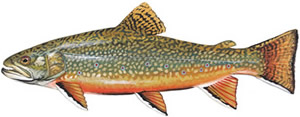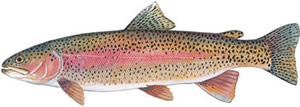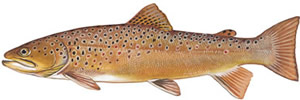SC Trout Species
THE BROOK TROUT Salvelinus fontinalis

The brook trout is a member of the genus Salvelinus, which contains salmonid species often called char or charr. Ranging from Georgia to the Arctic Circle, the brook trout is the only trout native to the southern Appalachians. Also known as the brookie, native, squaretail, speck or speckled trout, the brook trout’s original haunts have diminished because of the deterioration of suitable habitat and the introduction of other non-native trout species.
Known for their distinctive color pattern, the adults are greenish with impressed lines or worm-like vermiculations on the back, top of head and dorsal fin, while the sides are speckled with bright yellow spots mixed with brilliant red spots on sky-blue halos. The olive-green background grades to bright yellow followed by brilliant red on the belly of the fish. All of the bright red ventral fins have a distinctive white stripe along the leading edge margined with black, typical of the Salvelinus genus.
Spawning in October and November in the spring seeps of feeder streams, brook trout grow very slowly in the confines of their small habitat. Because of the restricted environment in South Carolina, most never grow longer than seven inches, with few exceeding eight or nine inches in length. The current state record, 2 pounds 6 ounces, was a fish of hatchery origin, rather than a native brookie. Though wary, brookies are more readily taken than any other trout.
The angler may choose from a wide assortment of baits and lures, including earthworms, spinners, spoons and flies. SCDNR stocks brook trout in some remote streams on a seasonal basis and in late winter and early spring put-take program stockings.
THE RAINBOW TROUT Oncorhynchus mykiss

A native to the West Coast of North America from lower California to Alaska, the rainbow trout has been widely introduced throughout the southern Appalachians. In its native region, the sea-run (or anadromous) individuals are known as steelheads, while resident fish confined to fresh waters are known as rainbow trout. One of the most widely distributed trout species in the world, its adaptability to hatchery propagation is probably the single-most important factor determining its extensive use in stocking programs. Various strains of captive rainbow trout spawn at different times of the year from fall to late winter. Therefore, by selecting different rainbow strains, with different spawning times, culturists can “program” grow-out to match stocking needs throughout the year.
A beautiful fish, the rainbow’s name refers to its colorful pinkish-red band, which extends from its gill plate along its sides. Numerous blackish or brownish spots mark the back as well as the dorsal, adipose and caudal or tail fin. These spots are better developed on the tail fin in this species than on the brown trout. Spots on rainbow trout are generally small and very numerous, unlike brown trout which have larger less numerous spots.
Unlike the other two trout species in South Carolina, wild rainbow trout normally spawn in late winter to early spring, generally in February and March. During the first year, the young feed on insects and other aquatic life until they grow four to five inches long. Wild rainbow trout in South Carolina grow slowly. When they are two years old, they will grow to seven or eight inches; and at three, they’ll grow to about nine or ten inches. In contrast, hatchery rainbow trout grow to about eight inches at one year of age, and by age two they are over 12 inches.
THE BROWN TROUT Salmo trutta

Brown trout, also known as German brown or Loch Leven brown denoting the source of importation, were imported into the United States in 1883. During the late 1800s and early 1900s, this species was widely distributed throughout North America. The brown is the most prevalent species along the lower gradient mica sand streams along the Chattooga Ridge in South Carolina.
The brown and the rainbow share some common characteristics in behavior, habitat and appearance but can still be easily identified as separate species. Adults of the brown trout may be distinguished from the rainbow by the absence of a reddish band along the sides, the presence of orange or reddish spots, sometimes with green margins, and the weak development or absence of dark spots on the tail or caudal fin. The brown trout typically inhabits lower gradient streams with good pool habitat and overhead cover. Brown trout are generally more tolerant of turbid, silted streams and generally out-perform rainbow trout in streams with heavy competition from other fishes. Many of the feeding habits of the two species are similar, although the brown is somewhat more nocturnal in its activities. The brown feeds heavily on insects as the other trout species do, but it is also more inclined to take fish, crayfish and salamanders. In some streams, the crayfish has been found to comprise half of larger wild brown trout’s diet. Like the brook trout, the brown spawns in the fall from late October through November.
Brown trout are the favorite of many skilled anglers, not only because they tend to live slightly longer and grow larger than the other two species but also because they are the most difficult of all trout to catch. They take most types of lures and bait well, but these must be presented skillfully and cautiously. Since browns tend to use undercut banks, rock ledges and fallen timber for cover, they are difficult to approach undetected. Brown trout fight very aggressively and tend to make long, forceful runs into deep pools when hooked. Brown trout aren’t known for making aerial acrobatic leaps like the rainbow trout.

